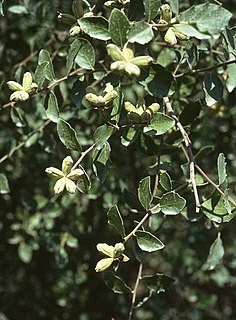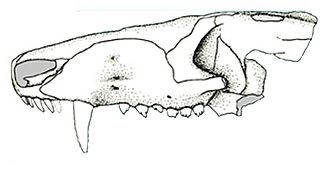
The Fabales are an order of flowering plants included in the rosid group of the eudicots in the Angiosperm Phylogeny Group II classification system. In the APG II circumscription, this order includes the families Fabaceae or legumes, Quillajaceae, Polygalaceae or milkworts, and Surianaceae. Under the Cronquist system and some other plant classification systems, the order Fabales contains only the family Fabaceae. In the classification system of Dahlgren the Fabales were in the superorder Fabiflorae with three families corresponding to the subfamilies of Fabaceae in APG II. The other families treated in the Fabales by the APG II classification were placed in separate orders by Cronquist, the Polygalaceae within its own order, the Polygalales, and the Quillajaceae and Surianaceae within the Rosales.
Saponins, also referred to selectively as triterpene glycosides, are bitter-tasting usually toxic plant-derived organic chemicals that have a foamy quality when agitated in water. They are widely distributed but found particularly in soapwort, a flowering plant, and the soapbark tree. They are used in soaps, medicinals, fire extinguishers, speciously as dietary supplements, for synthesis of steroids, and in carbonated beverages. Structurally, they are glycosides, sugars attached to another organic molecule, usually a steroid or triterpene, a steroid building block. Saponins are both water and fat soluble, which gives them their useful soap properties. Some examples of these chemicals are glycyrrhizin, licorice flavoring; quillaia(alt. quillaja), a bark extract used in beverages; and squalene, a vaccine adjuvant.

The Mexican free-tailed bat or Brazilian free-tailed bat is a medium-sized bat native to the Americas, regarded as one of the most abundant mammals in North America. Its proclivity towards roosting in huge numbers at relatively few locations makes it vulnerable to habitat destruction in spite of its abundance. It has been claimed to have the fastest horizontal speed of any animal, reaching top ground speeds over 100 mph (161 km/h); its actual air speed has not been measured. The Texas Legislature designated the Mexican free-tailed bat the state mammal (flying) in 1995.
Quillaia is the milled inner bark or small stems and branches of the soapbark. Other names include Murillo bark extract, Panama bark extract, Vanilla extract, Quillaia extract, Quillay bark extract, and Soapbark extract. It contains a high concentration of saponins which is increased by processing; highly purified quillaia is used to enhance vaccines. Other compounds in the extract include tannins and other polyphenols, and calcium oxalate. It is listed as an ingredient in root beer and cream soda.

QS-21 is a purified plant extract used as a vaccine adjuvant. It is derived from the soap bark tree, which is native to the country of Chile.

Quillaja saponaria, the soap bark tree or soapbark, is an evergreen tree in the family Quillajaceae, native to warm temperate central Chile. In Chile it occurs from 32 to 40° South Latitude approximately. Populations are found even 2000 m (6500 ft) above sea level. It can grow to 15–20 m (50–65 ft) in height. The tree has thick, dark bark; smooth, leathery, shiny, oval evergreen leaves 3–5 cm long; white star-shaped flowers 15 mm diameter borne in dense corymbs; and a dry fruit with five follicles each containing 10–20 seeds.

Hevea is a genus of flowering plants in the spurge family, Euphorbiaceae, with about ten members. It is also one of many names used commercially for the wood of the most economically important rubber tree, H. brasiliensis. The genus is native to tropical South America but is widely cultivated in other tropical countries and naturalized in several of them. It was first described in 1775.

The giant otter or giant river otter (Pteronura brasiliensis) is a South American carnivorous mammal. It is the longest member of the weasel family, Mustelidae, a globally successful group of predators, reaching up to 1.7 metres (5.6

The Brazilian brown bat, is a bat species from South and Central America.

The largetooth cookiecutter shark is a rare species of squaliform shark in the family Dalatiidae, reported from depths of 60–200 m (200–660 ft) at scattered locations in the Atlantic and Pacific Oceans. As its common name suggests, it is similar in appearance to the cookiecutter shark but has much larger lower teeth. This species reaches a maximum known length of 42 cm (17 in). The largetooth cookiecutter shark feeds by gouging out chunks of flesh from larger animals, including bony fishes, sharks, and marine mammals, and is able to take larger bites than I. brasiliensis. Little is known of its life history; it is thought to be a weaker swimmer than I. brasiliensis, and is presumably aplacental viviparous like the rest of its family. This shark is an infrequent bycatch of commercial trawl and longline fisheries, but is not thought to be much threatened by these activities.

Prozostrodon is an extinct genus of advanced cynodonts that was closely related to the ancestors of mammals. The remains were found in Brazil and are dated middle to late Triassic. It was originally described as a species of Thrinaxodon and was probably fairly similar to that genus in overall build. The holotype has a skull length of 6.7 cm, indicating the whole animal may have been the size of a cat, though there is some doubt as to whether the find represents an adult individual. The teeth were typical of advanced cynodonts, and the animal was probably a small carnivore hunting reptiles and other small prey.

Paracoccidioides brasiliensis is a dimorphic fungus and one of the two species that cause paracoccidioidomycosis. The fungus has been affiliated with the family Ajellomycetaceae although a sexual state or teleomorph has not yet been found.

Senecio brasiliensis, known by the common name flor-das-almas, (flower-of-souls), is a perennial species of the genus Senecio and family Asteraceae. It is native to fields and meadows of central South America.

Quillajaceae is a family of flowering plants. It contains only two extant species, Quillaja brasiliensis and Quillaja saponaria, and one fossil species, Dakotanthus cordiformis.

Quillaja is a genus of flowering plants, the only extant genus in the family Quillajaceae with two or three known species. It was once thought to be in the rose family, Rosaceae, but recent research shows it belongs in its own family. The inner bark of the soap bark tree contains saponin, which is a natural soap. Members of this genus are trees that grow to about 25 metres (82 ft).

Garcinia gardneriana, the bacupari, is an evergreen, dioecious species of the genus Garcinia. It is distributed throughout South America's Amazon Basin and produces fruit with edible arils. In Brazil there is currently research to use this fruit to combat cancer.
Aetobarbakinoides is an extinct genus of stagonolepidid aetosaur known from the Late Triassic of Rio Grande do Sul state, southern Brazil. Fossils have been found from the Santa Maria Supersequence of the late Carnian and early Norian stages, making Aetobarbakinoides one of the oldest aetosaurs. The type species, A. brasiliensis, was named in 2012, and is notable for being described primarily by features of the vertebrae; most other aetosaurs are diagnosed by features in bony plates called osteoderms, which are by far the most common material. Although placed in a basal phylogenetic position among aetosaurs, Aetobarbakinoides is closely related to both desmatosuchines and typothoracisines, two derived clades of aetosaurs.

Schinopsis brasiliensis is a species of flowering plant in the cashew family known by the common names baraúna or braúna.

Massetognathinae is an extinct subfamily of cynodonts in the family Traversodontidae. It includes four species from the Middle and Late Triassic: Massetognathus pascuali from Argentina, Massetognathus ochagaviae and Santacruzodon hopsoni from southern Brazil, and Dadadon isaloi from Madagascar. Massetognathines have several distinguishing characteristics, including flattened skulls, small canine teeth, and postcanine teeth with three cusps on their outer edges. Massetgognathinae was defined by Kammerer et al. (2012) as the clade containing all traversodontids more closely related to Massetognathus pascuali than to Gomphodontosuchus brasiliensis, and is the sister taxon of the traversodontid subfamily Gomphodontosuchinae, which was defined by Kammerer et al. (2008) as all traverodontids more closely related to G. brasiliensis than to M. pascuali.
Arctotraversodontinae is a subfamily of Late Triassic cynodonts belonging to the family Traversodontidae. Members of the subfamily include Arctotraversodon, Boreogomphodon and Plinthogomphodon from North America, and Habayia, Maubeugia, Microscalenodon and Rosieria from Europe.
















